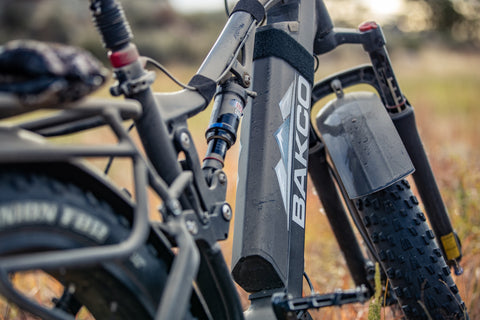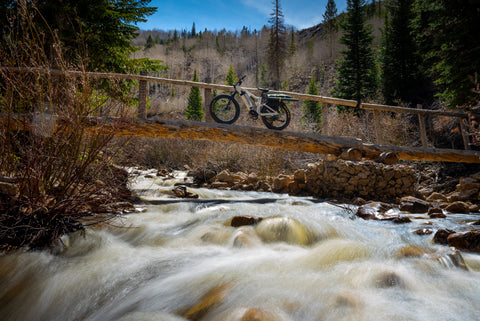Hardtail vs. Full-Suspension Electric Bikes: What’s Different & Which is Better?
Purchasing an electric bike, or even a traditional bike, typically requires you to make quite a few decisions. Things like what color you want, what frame size, your purpose for the electric bike, and frame type are all things to consider. While these are all based mainly on personal preference, one tough choice is whether you want a hardtail or a full-suspension electric bike.
If you're wondering what the difference between a hardtail and a full-suspension electric bike is, we're here to help! For now, we’ll give you the easy answer and then dive into the details a bit later. Hardtail bikes have only a suspension front fork, and the frame is rigid. Meanwhile, a full-suspension bike has both the front fork suspension and a rear suspension, and the frame is two separate pieces.
As we mentioned, deciding between the two comes down to personal preference and preferred riding style. Our goal at Bakcou is to give you the information you need to make the right decision. In this blog, we're explaining the differences between a hardtail bike and a full-suspension electric bike. We're also giving a breakdown of the pros and cons of each. From there, we hope you feel more confident in deciding on purchasing your new Bakcou electric bike.

HARDTAIL BIKES
Let’s start with hardtail electric bike frames. Hardtail electric bikes are what most leisurely bicyclists are most familiar with, as they are a bit more popular in the bike market. As previously mentioned, Hardtail bikes have only the front fork suspension and a completely rigid frame. Front fork resistance is provided by metal coils or compressed air. On a hardtail bike, the bumps and vibrations can only be absorbed by the suspension fork. The suspension fork can help improve the rider’s handling and steering while out on rougher trails. Hardtail bikes are often a popular choice for cross country riding, trail riding, and bikepacking and are the top choice for those who enjoy riding at a more leisurely level. At Bakcou, the Mule, our hardtail electric bike with a mid-drive motor, continues to be our number one selling eBike.
PROS
The frame of a hardtail electric bike is rigid, meaning it is one single piece. A hardtail frame is typically lighter than its full-suspension electric bike counterpart. This makes it a better choice for long-distance riders or those who climb high elevations often. Efficiency is increased on a hardtail because the rigid frame transfers power from the pedals to the rear wheel. The lighter weight means riders expend less energy to accelerate and maintain speed. On a hardtail, there is no pedal bob. As a result, more energy will drive the bike forward when pedaling. Both of these will increase the bike's efficiency. On a hardtail, riders won't lose energy compressing the rear suspension. As a result, a hardtail has a faster ride when climbing or navigating easy terrain.
Another important aspect is the design, mechanics, and durability of a hardtail bike. The design of a hardtail allows it to have a front derailleur in addition to the rear derailleur. This gives you more gearing options during your ride. We’ve already discussed in length the rigid frame design of the hardtail bike. This ties into the increased durability of a hardtail. A hardtail bike can withstand much harder impacts with little to no damage than its full-suspension counterpart can. On a hardtail, all of the tubes are welded together and there are no fragile linkages or pivot points. When it comes to the mechanics of a hardtail bike, they are much easier to repair and require less frequent maintenance. Easier maintenance and higher durability are important. It allows you to spend less time fixing your bike and more time getting out and riding the trails. All riders can agree that more time on the bike is the ultimate goal.
Good for Beginners
Hardtail bikes are the go-to bike for beginners for a multitude of reasons. First, hardtail bikes allow you to feel more connected to the trail because they provide more feedback. They also force riders to learn proper mountain biking techniques. Being forced to learn correct techniques can only benefit riders in the long run. The skills learned on a hardtail are transferable to a full suspension and contribute to being a better rider.
Compared to a full-suspension bike, a hardtail is more versatile and is more suitable for several riding types. In addition to their versatility, hardtail bikes are less expensive than full-suspension bikes. They are typically about $800-$1000 cheaper.
CONS
Because a hardtail and a full-suspension electric bike are relatively the same, besides that rear suspension, most of the cons of a hardtail bike result from not having a shock absorber. A hardtail bike can be less comfortable and less efficient than its full-suspension counterparts. They can also be less capable as they don’t get as much traction and can’t handle the same drops and jumps. Finally, the last notable downside to a hardtail is the lack of adjustment options compared to a full-suspension bike.

FULL-SUSPENSION ELECTRIC BIKES
A full-suspension electric bike has both the front fork suspension and a rear suspension shock. Both shocks work together to absorb most of the rocks, bumps, and uneven terrain and the vibrations that come with them. The absorber makes for a much more comfortable ride and more efficient on rougher terrain. The full suspension also typically improves traction, control, and handling. Full-suspension bikes are the better choice for all types of mountain biking – downhill, trail riding, enduro, and CX. In the Bakcou world, full-suspension electric bikes are also a good option for those whose hunts or backcountry adventures take them to the top of a mountain or rocky hill.
PRO
For experienced riders, full-suspension electric bikes can improve their riding experience. The suspension system ensures that tires maintain contact with the ground at all times, giving riders better traction and handling control. The same suspension system also absorbs shocks and dampens vibrations from rocks, bumps, and roots in the trail, which makes it much more stable and efficient. The bike won't move around too much when you hit rocks and bumps. Not to mention, riders won’t lose their forward momentum on rough trails. The rear shock allows wheels to continue to roll over bumps, whereas on a hardtail, the wheels would bounce off the rocks and slow the bike down.
On a full-suspension electric bike, the frame consists of two pieces. The two pieces of the frame are the mainframe and the swingarm. The rear shock is integrated into the frame and attaches both frame pieces. Because more research and development is put into the engineering of full-suspension frames and shock absorbers, they are much more technologically advanced. An added advantage of a full-suspension bike is its adjustability. Rear shocks offer multiple adjustment points so riders can dial in the bike specifically to their liking.
Full-suspension electric bikes allow riders to reach and maintain higher speeds on technical trails because of the additional traction and shock absorption. Coupled with the ability to reach higher speeds is the capability of full-suspension bikes to hit drops and jumps because the suspension absorbs a lot of the impact when you make contact back with the ground. This impact is often hard to handle on a hardtail bike. These advantages make full-suspension electric bikes the better choice for all types of mountain biking – downhill, trail riding, enduro, and CX.

CONS
Like any fun, advanced product, there are always a few cons to go along with the pros. Let’s look at a few of the disadvantages of a full-suspension bike. The first, easiest downfall to get out of the way is the price. A full suspension bike is typically $800-$1200 more than a hardtail. Even if you found a full-suspension for the same price as a hardtail, the hardtail will usually have higher-end components and design than a full-suspension for the same price.
Because full-suspension electric bikes are more forgiving, they are not a great learning tool for newer riders. A wider margin of error allows riders to ride above their skill level and can make up for the shortcomings of the rider. With the bike compensating for mistakes or lack of skill, riders can ride sloppily, roughly, or lazily and not know it. This compensation can lead to developing bad habits in their cycling skills, which can be detrimental in the long run.
Full-suspension electric bikes are typically about two to four pounds heavier than a hardtail. They’re also less efficient and provide less trail feedback, both of which can greatly influence your ride. Not to mention, they’re less versatile than a hardtail bike. Full-suspension bikes are better suited for mountain biking and rougher terrain, whereas a hardtail is better for numerous uses.
Finally, full-suspension electric bikes require more maintenance than hardtail bikes. More moving parts mean that not only are there more parts that need periodic maintenance and tune-ups, but there are more parts that can fail or wear out over time. For less mechanically inclined riders, this frequent maintenance can be a headache.

WHICH ELECTRIC BIKE IS BEST FOR ME?
Unfortunately, there isn't a simple, cut-and-dry answer for telling you which one is best for you. As mentioned, choosing between a hardtail and a full-suspension frame is a matter of personal preference and riding style. Both bikes have benefits, and both bikes have their downsides as well.
The main things to consider when deciding are your budget and the terrain you plan to ride, plus your skill level. For experienced rider looking to spend more time riding rough trails, we’d lean towards a full-suspension bike. If you’re a newer rider or just looking to get out for some leisurely exercise with a few mountain trails thrown in, a hardtail bike will suit your needs (and then some) just fine.
When you're on a tighter budget, you’re likely to have a wider variety of hardtail bikes available to choose from than full-suspension electric bikes. In this case, unless you need the rear suspension for the terrain you’re riding, we’d lean towards a hardtail with a few higher-end upgrades than an entry-level full-suspension.
The decision is also dependent on your level of comfort in handling the bike, riding different terrains, and maintaining control of the bike. Hardtails are a better option for learning, whereas a full-suspension bike will give you a more comfortable ride. Hardtail bikes are a little faster and more adept, but a full-suspension electric bike conserves your speed on rocky terrain. It all comes down to preference and what you want out of your bike.
Summary
In the end, only you can decide what bike is best for you. Here at Bakcou, our goal is to lay out all of the options and advantages and disadvantages to our customers to help them make the best decision for themselves. We want our customers to love their electric bikes for years to come. We hope this has helped you learn more about the similarities and differences between a hardtail and a full-suspension electric bike. If you have any questions or are interested in purchasing a Bakcou electric bike of your own, reach out, and we’d be happy to help you out!


